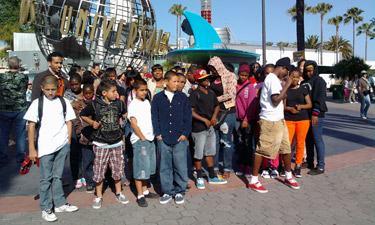 It’s no surprise to anyone that Los Angeles has its share of problems with gang violence—the L.A. Police Department reports more than 450 gangs and 45,000 current members, and they’ve verified more than 16,000 violent gang crimes in the past three years, including homicides, felony assaults, robberies, and rapes. In many cases, gang recruitment begins as early as elementary school, as younger children are more easily manipulated by older gang members they idolize and wish to emulate.
It’s no surprise to anyone that Los Angeles has its share of problems with gang violence—the L.A. Police Department reports more than 450 gangs and 45,000 current members, and they’ve verified more than 16,000 violent gang crimes in the past three years, including homicides, felony assaults, robberies, and rapes. In many cases, gang recruitment begins as early as elementary school, as younger children are more easily manipulated by older gang members they idolize and wish to emulate.
Since gangs are often divided along territorial neighborhood lines, and the City of Los Angeles Department of Recreation and Parks (RAP) has facilities all across the city, the agency saw a unique opportunity to bring kids from different neighborhoods together and get them to interact and build relationships, thus breaking down the “otherness” that’s central to gang rivalry. The RAP itself hadn’t been immune to gang violence—a former employee was actually shot in the line of duty, and the parks were often the scenes of sometimes-bloody conflicts between opposing gangs.
Karl Stephens and Gregory Thomas of the RAP and Jack Foley of Los Angeles People for Parks conceived the initial idea, naming it the Watts Cluster Project to capture the unifying theme of the initiative. The goal was to use recreation programs to bring together kids from the often-warring housing projects of Nickerson Gardens, Jordan Downs, and Imperial Courts, all located within the Watts community in southern Los Angeles. The first events were held in 2009, and since then, the program has become a popular social outlet for at-risk kids aged 8 to 14. Even better, gang and crime statistics have shown a marked decline since the advent of the project.
“Over the past three years, we have serviced more than 400 youth in our program,” Thomas says, noting that participation has increased 10 to 15 percent each year. There has also been a “20 percent decrease in gang activity among youth participating in our program, a 15 percent decrease in gang violence during the hours the youth are participating, and improved attitude during school hours among youth participating in our program, i.e., they are less likely to get into gang-motivated conflicts, as a result of their participation,” he says.
Program sports include basketball, baseball, soccer, flag football, and more, and organizers intentionally mix kids from different neighborhoods together on teams to decrease the perceptions they might have had about youth from other areas. Program participants can also take part in sponsored field trips, ranging from kayak excursions on the shore to a day at Universal Studios.
While the numbers are impressive, Thomas also notes the difference the program has played in the lives of the individual kids who are involved. One youth, nicknamed “Booger,” was a community menace by the age of nine, and he regularly threatened visitors to some of the local parks.
“Booger was always into trouble,” Thomas reflects. “He smoked weed and consumed alcohol regularly, and was often robbing and stealing just to survive. He also would hang out at the park to see how many kids he could scare off. He was less than four feet tall, weighed about 55 pounds, and was feared by most kids his age.”
Booger was arrested during a high-speed chase where he was a passenger in a stolen car driven by a 12-year-old, and the Watts Cluster Project organizers took a personal interest in his rehabilitation. Due in large part to their influence and the effect of the program, Booger has gone from being a juvenile delinquent to an upstanding citizen.
“He currently is getting As and Bs on his report card, and he follows all the rules and functions well in society,” says Thomas. “He has become a model youth and his attitude on life is awesome.” Program organizers still visit him regularly, offering support and rewarding him for his outstanding transformation.
Making a dent in the L.A. gang problem will take an ongoing, multifaceted approach, but for the hundreds of kids who have benefited from the Watts Cluster Project, the future is looking bright.
Danielle Taylor is Associate Editor of Parks & Recreation.

